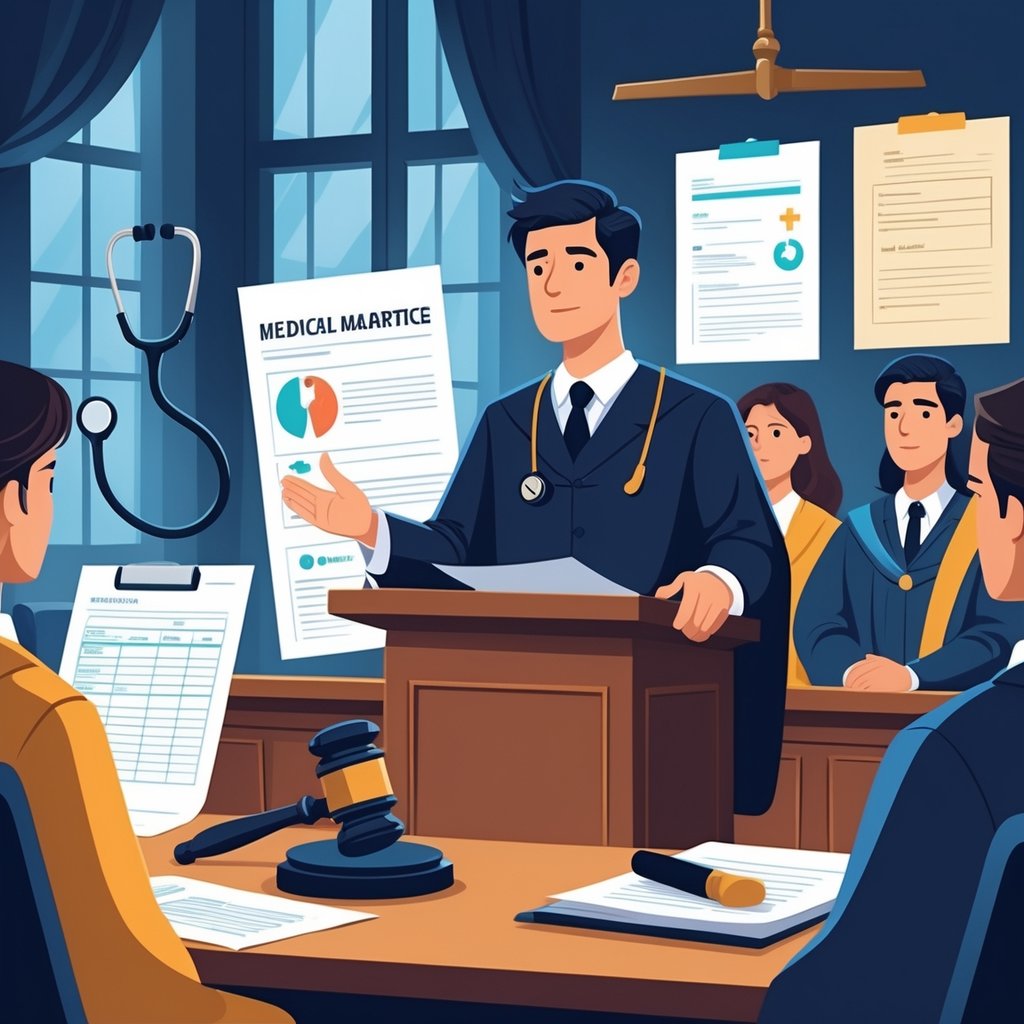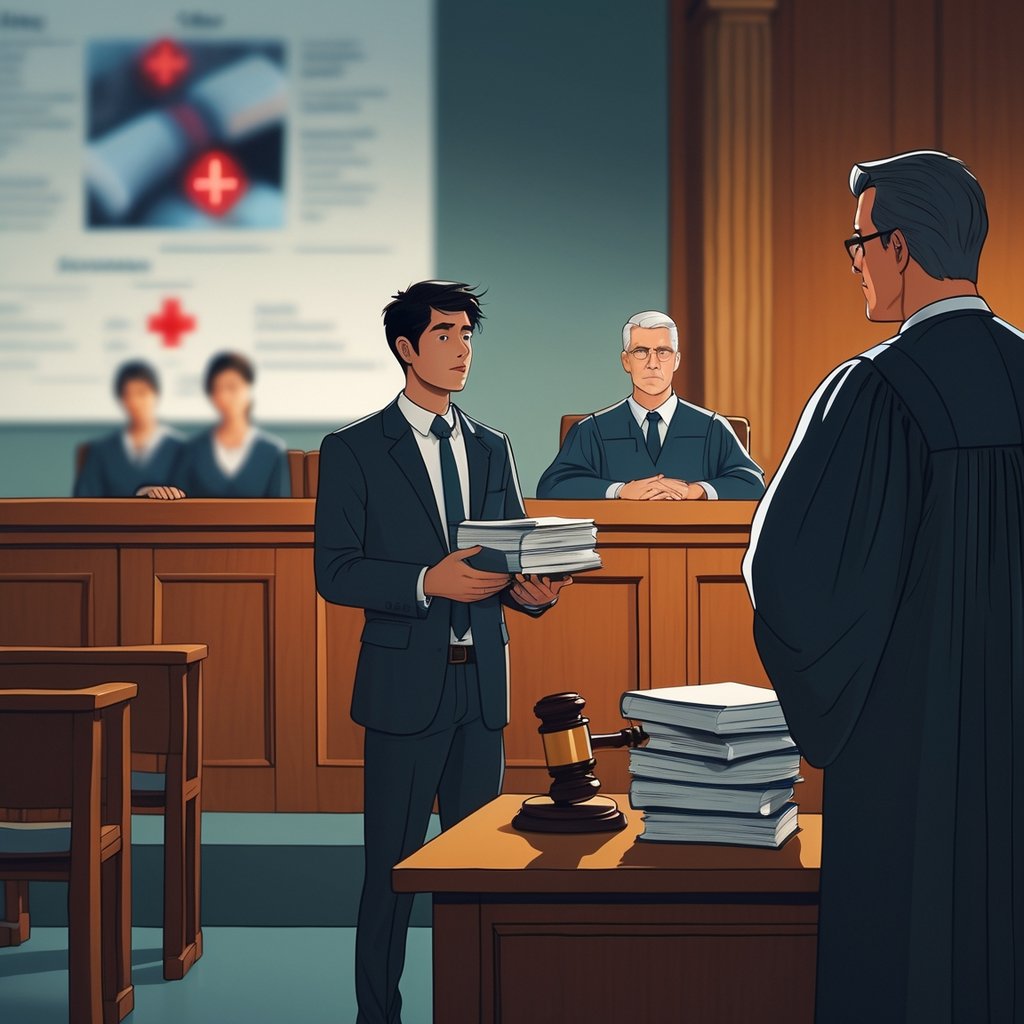When you suffer harm from medical treatment, you might wonder if you can handle your legal case alone. You legally have the right to represent yourself in a medical malpractice lawsuit, but it comes with significant challenges and risks.
Medical malpractice cases involve complex legal procedures and detailed medical knowledge that most people just don’t have.
You need to prove that a healthcare provider failed to meet the standard of care and caused your injury. That means expert witnesses, medical records, and a solid grasp of both legal and medical concepts.
The process can be overwhelming, especially when you’re trying to recover from your injuries at the same time.
You can file a malpractice suit without a lawyer, but your success hinges on navigating court procedures, gathering evidence, and presenting a strong case.
Key Takeaways
- You can legally represent yourself in medical malpractice cases, but you’ll need extensive knowledge of law and medicine.
- Medical malpractice cases need expert witnesses and proof that healthcare providers violated the standard of care.
- Self-representation carries major risks and challenges, so hiring an experienced lawyer is often the smarter move.
Your Right to Self-Representation in Medical Malpractice Cases

You have an absolute right to represent yourself in any civil case, including medical malpractice lawsuits.
This right comes with specific legal protections, but also some important limitations you should know.
Legal Basis for Self-Representation
Your right to self-representation comes from the Constitution and legal precedent. You can handle your own medical malpractice case without hiring a lawyer.
The legal system calls this “pro se” representation. You have the legal right to bring a medical malpractice case on your own without any attorney involvement.
Courts have to let you represent yourself in your medical malpractice lawsuit. They can’t force you to hire a lawyer.
Your pro se status gives you access to the same legal procedures as attorneys. You can file motions, present evidence, and argue your case in court.
Eligibility Criteria and Limitations
Most people can represent themselves in medical malpractice cases. Still, some situations might limit this right.
Basic Requirements:
- You must be mentally competent.
- You must be at least 18 years old.
- You can’t have a history of filing frivolous lawsuits.
Judges can restrict your right in rare cases. A judge may limit the right to file if you repeatedly file abusive and meritless cases.
You have to follow all court rules and deadlines. Missing important deadlines could get your case dismissed.
If you want to represent a minor or someone else, you’ll usually need a lawyer. You can only represent yourself in your own medical malpractice case.
Key Differences From Other Civil Cases
Medical malpractice cases have unique requirements that make self-representation more challenging than other lawsuits.
Special Filing Requirements:
- Certificate of merit in many states
- Pre-lawsuit screening panels
- Expert witness requirements
- Shortened statute of limitations
Many states require medical malpractice plaintiffs to jump through special procedural hoops at various points in the case.
You need to prove complicated medical standards of care. That takes understanding both legal and medical concepts, which isn’t typical for most civil cases.
Expert witnesses cost thousands of dollars and are almost always required. Other civil cases might not need expert testimony at all.
Insurance companies provide experienced defense attorneys for doctors. This creates a pretty uneven playing field compared to simpler disputes.
Fundamental Elements of a Medical Malpractice Case

Medical malpractice cases require proving four core elements to establish a valid claim. You’ll need to show a breach of the standard of care, link the error to your injuries, and prove you suffered damages because of it.
Breach of Standard of Care
The standard of care is the level of treatment a reasonable medical professional would provide in similar circumstances. You need to prove your doctor didn’t meet that standard.
Expert witnesses are required to establish the standard of care in your case. These experts must practice in the same specialty as the doctor you’re suing.
Key requirements include:
- Expert testimony from qualified medical professionals
- Documentation of accepted medical practices
- Evidence showing how your care differed from the standard
Expert witnesses charge thousands of dollars to get involved. They review your records, write reports, and testify about what should’ve happened.
The breach has to be significant enough that other doctors would call it negligent. Minor differences in treatment usually don’t count as malpractice.
Causation and Proof Requirements
Causation links the medical error directly to your injuries. You need to show the doctor’s mistake caused your harm, not just an underlying condition.
There are two types of causation in medical malpractice. Factual causation means the negligence actually caused your injury. Legal causation means the harm was a foreseeable result of the error.
Medical records matter a lot for proving causation. You’ll need documentation showing your condition before and after the alleged malpractice.
Evidence requirements include:
- Complete medical records from all providers
- Timeline of symptoms and treatment
- Documentation of worsening condition
Pre-existing conditions make causation claims trickier. You have to separate harm from the original issue versus damage from negligent care.
Types of Recoverable Damages
Medical malpractice damages fall into three main categories. Economic damages cover financial losses like medical bills and lost wages.
Non-economic damages include pain and suffering, emotional distress, and loss of enjoyment. You’ll need to document how the malpractice changed your daily life.
Punitive damages come up in rare cases with extreme negligence or intentional misconduct. Most states limit or cap certain types of damages in these cases.
| Damage Type | Examples | Documentation Needed |
|---|---|---|
| Economic | Medical bills, lost wages | Receipts, pay stubs, tax returns |
| Non-economic | Pain and suffering, disability | Medical records, testimony |
| Punitive | Gross negligence | Evidence of willful misconduct |
Future damages might include ongoing care and lost earning capacity. You’ll need to prove these losses will continue after the trial.
Step-by-Step Process to Represent Yourself

Handling your own case involves three main phases. First, gather your medical documentation. Next, meet all legal requirements before filing. Then, prepare and file your formal complaint.
Each step has strict deadlines and requirements. Missing just one can derail your case.
Obtaining Medical Records and Assessment
You’ll need complete medical records from every provider involved in your treatment. Start by requesting records from hospitals, doctors, specialists, and any other medical facilities.
Most providers charge fees for copying records. These fees usually range from fifty cents to two dollars per page.
Request records in writing and keep copies of everything you send.
Your records should include:
- Treatment notes from all appointments
- Test results like lab work and imaging
- Medication records and prescriptions
- Surgical reports if you had surgery
- Discharge summaries from hospital stays
Once you have your records, you’ll need a medical assessment from an expert. This expert must review your case and decide if malpractice happened.
The expert should work in the same specialty as the provider you’re suing. They compare your treatment to accepted standards.
Without this assessment, your case will probably fail.
Finding an expert isn’t cheap. Costs often run from five hundred to two thousand dollars for a first review. Some charge hourly rates between three hundred and eight hundred dollars.
Filing a Notice and Pre-Lawsuit Requirements
Many states make you notify the medical provider before you file your lawsuit. This notice has to go out within a certain time, usually sixty to ninety days before filing.
Pre-litigation requirements vary by jurisdiction. Some states require mediation or arbitration. Others need a certificate of merit from a qualified expert.
Your notice should include:
- Details of the alleged malpractice
- Injuries you suffered
- Damages you’re seeking
- Timeline of events
Check your state’s statute of limitations closely. Most states give you one to three years from when you discovered the injury. Miss that deadline and you lose your right to sue.
Some states use medical review panels to evaluate your case first. Others require you to try settling through mediation.
Research your local requirements thoroughly. Keep detailed records of all your communications with the provider. Save certified mail receipts and delivery confirmations as proof you followed the rules.
Drafting and Filing the Complaint
Your complaint is the legal document that starts your lawsuit. It needs to clearly state what the provider did wrong and how it harmed you.
The complaint should include:
- Jurisdiction and venue information
- Factual background of your treatment
- Legal theories like negligence
- Damages you suffered
- Relief sought including compensation
Drafting the complaint takes precise language and you must follow court formatting rules. Errors can get your case tossed out.
Include specific dates, times, and actions for each provider. Avoid vague statements and stick to facts you can back up.
Filing fees usually range from one hundred to five hundred dollars, depending on your court. Many courts now require electronic filing.
After you file, you have to serve the complaint on each defendant within the required time. This usually means hiring a process server or using certified mail.
If you don’t serve the complaint correctly, your case might get dismissed.
Challenges and Risks of Self-Representation

Medical malpractice lawsuits are full of complex legal standards, strict procedural rules, and big financial risks. These factors create real obstacles for people who try to handle their cases without professional legal help.
Complexity and Legal Standards
Medical malpractice cases ask you to prove four things: duty of care, breach, causation, and damages. Each piece comes with its own legal standards, which change from state to state.
You’ll need to get comfortable with medical terminology and procedures. Usually, you’ll have to bring in expert medical testimony to show what the standard of care was and how your provider fell short.
The complexity of medical malpractice laws makes it tough to handle these cases without deep legal knowledge. State laws can be wildly different when it comes to things like damage caps, statutes of limitations, and what paperwork you need.
Key Legal Challenges:
- Understanding medical records and terminology
- Finding the right medical experts
You’ll also have to meet the burden of proof and handle state-specific regulations. Calculating the monetary value of your damages is part of the process too.
This means adding up your current and future medical bills, lost wages, and pain and suffering.
Procedural Pitfalls and Deadlines
Courts set strict deadlines and formatting rules for medical malpractice lawsuits. Miss just one deadline and your case could get thrown out.
You have to file within your state’s statute of limitations. That window usually falls between one and four years from when you discovered the harm.
Procedural mistakes can be costly. Courts hold you to the same standards as lawyers, no matter how unfair that seems.
Common Procedural Requirements:
- Pre-litigation notice
- Certificate of merit filings
You’ll also have to keep up with discovery deadlines and expert witness disclosures. Many states want you to get a certificate of merit before you even file, showing an expert thinks your case has real substance.
Handling depositions and expert witnesses takes legal know-how. Knowing what questions to ask and what evidence to use is crucial.
Cost Considerations
Sure, you’ll save on attorney fees if you go it alone. But medical malpractice cases rack up serious costs up front.
Expert witness fees can run $500 to $1,000 per hour. You’ll probably need several experts to review records and testify, with total costs sometimes hitting $10,000 to $50,000 or more.
Getting medical records isn’t free, either. You might need records from several providers or hospitals.
Typical Case Expenses:
- Medical expert witness fees: $10,000 to $50,000
- Court filing fees: $300 to $500
- Medical record costs: $500 to $2,000
- Deposition transcripts: $200 to $500 each
Settlement negotiations aren’t easy. Insurance companies have seasoned attorneys who know all the tricks and may lowball you if you’re unrepresented.
Your time investment will be huge. These cases often drag on for 12 to 24 months and demand hundreds of hours of your attention.
Negotiating a Settlement Without Legal Counsel

You can try to settle your malpractice case before filing a lawsuit. But dealing with insurance companies and figuring out fair compensation isn’t simple.
Dealing With Insurance Companies
Insurance companies have teams of adjusters and lawyers whose job is to pay as little as possible. They know you probably don’t have legal training and might use that against you.
Write everything down. Keep records of every phone call, email, and letter. Insurance adjusters sometimes make promises over the phone that vanish later.
Never take the first offer. It’s almost always too low. They expect you to negotiate.
Watch what you say. Don’t admit fault or play down your injuries, even in casual conversation.
Key things to remember:
- Get every agreement in writing
- Read before you sign anything
- Ask for time to review offers
- Request written explanations for low offers
Settlement Strategies
Negotiation takes preparation. Start by gathering all your medical records.
Add up your total damages before making demands. Include every medical bill, future treatment, lost wages, and pain and suffering.
Be professional. Write a demand letter that spells out what happened, how it affected you, and why you deserve compensation.
Negotiation tactics that help:
- Start with a higher demand than you expect to get
- Know your minimum, but be ready to compromise
- Use medical evidence to back up your claims
- Stay calm and professional
Assessing Fair Compensation
Fair compensation covers different types of damages. Economic damages are things like medical bills, lost wages, and future care costs.
Non-economic damages cover pain, emotional distress, and loss of enjoyment. These are harder to put a number on, but they matter.
Medical bills usually anchor the settlement. Gather every bill tied to your treatment, including:
| Expense Type | Examples |
|---|---|
| Emergency care | Hospital visits, ambulance rides |
| Ongoing treatment | Doctor visits, therapy sessions |
| Medications | Prescriptions, medical devices |
| Future care | Estimated costs for continued treatment |
Check out similar cases in your area to get a sense of what settlements look like. Still, missing key legal rights or steps is a big risk when you handle negotiations yourself.
Look at the big picture. Lost income, reduced earning ability, and ongoing pain all count toward fair compensation.
When to Consider Hiring a Medical Malpractice Lawyer

Most medical malpractice cases need expert legal skills and resources to prove negligence. The strict rules and complex evidence make professional help almost essential.
Signs You Need an Attorney
You should get a medical malpractice attorney if your case involves serious injuries with big medical bills or long-term disability. Cases with multiple providers are especially tough to handle solo.
Complex medical issues need expert testimony to prove the standard of care was missed. A medical professional’s actions have to be weighed against accepted practices.
Consider hiring an attorney if you’re dealing with:
- Permanent disability or disfigurement
- Wrongful death in the family
- Birth injuries to mother or child
- Surgical mistakes like wrong-site surgery
- Misdiagnosis that delayed treatment
A medical malpractice lawyer can get expert opinions and manage the technical side. They know how to work with medical experts who can break down complex procedures for a jury.
Risks of Proceeding Alone
Handling a medical malpractice lawsuit yourself is tough and risky. Missing a deadline can kill your case for good.
You’ll need expert witnesses who charge thousands. Finding medical professionals willing to testify against their peers is a challenge.
Procedural mistakes might get your case dismissed before you even reach trial. Courts have strict rules for filing, serving defendants, and discovery.
Insurance companies have experienced lawyers who know how to defend these cases. They may offer low settlements to people without attorneys.
Gathering evidence takes skill. You need to know which medical records to request and how to keep them safe. Missing important evidence weakens your case.
Selecting the Right Legal Representation
Pick a medical malpractice attorney who focuses on these cases, not just general personal injury. Many offer free first consultations to review your situation.
Experience really matters. Ask about their results in cases like yours and their recent settlements.
Consider these points when choosing an attorney:
| Factor | What to Look For |
|---|---|
| Specialization | Focus on medical malpractice only |
| Resources | Can hire expert witnesses |
| Track Record | Success with similar cases |
| Communication | Explains legal process clearly |
State and local bar associations have directories of attorneys who specialize in medical malpractice. Talk to a few before deciding.
Most medical malpractice lawyers work on contingency fees. They only get paid if you win, so you can pursue your case without paying up front.
Frequently Asked Questions

People often want to know how to file medical malpractice cases without lawyers, what attorneys look for, and what the odds of winning are. Knowing these details helps you make better choices about your options.
What steps are necessary to file a medical malpractice lawsuit without legal representation?
You can file a medical malpractice claim without a lawyer, but the process is complicated. First, gather all your medical records from the provider who treated you.
Next, find expert witnesses in the same medical field as the doctor you’re suing. Expert witnesses have to establish the standard of care in these cases.
Check your state’s statute of limitations. Filing deadlines range from one to three years depending on where you live.
You’ll need to fill out court forms correctly and pay filing fees. Then serve legal papers to the defendants, following the court’s rules.
What criteria must be met for a malpractice attorney to accept a medical negligence case?
Attorneys look for clear proof that a healthcare provider failed to meet the standard of care. They want cases where the patient suffered real harm or financial loss as a direct result.
Most lawyers prefer cases with strong expert testimony. They also look at whether the damages are big enough to cover the high costs of litigation.
Strong medical records matter. Lawyers want detailed documentation showing what went wrong and how it hurt you.
Time limits count. If you waited too long, you might have missed your chance to file.
What qualifications should one look for in a lawyer when intending to sue a medical professional or institution?
Find attorneys who focus on medical malpractice, not just general personal injury. Experience with cases like yours gives them better insight into the medical issues.
Ask how many medical malpractice cases they’ve handled and their success rate. Check if they have good relationships with medical experts in your area.
Trial experience is important since many of these cases go to court. Insurance companies often fight hard against malpractice claims.
Make sure the lawyer has the resources to handle expensive expert fees and medical reviews. These cases cost more than most lawsuits.
What is the process for filing a claim against a healthcare provider for medical negligence?
Start by getting copies of all your medical records from every provider involved. Look through them to spot what went wrong.
Talk to medical experts to see if the provider broke the standard of care. You’ll need these experts to explain how the provider’s actions differed from what other doctors would’ve done.
File your complaint with the right court before the statute of limitations runs out. Explain clearly what the provider did wrong and how it harmed you.
Serve legal papers to all defendants as the rules require. Then get ready for discovery, where both sides exchange information and take depositions.
What actions can be taken if a lawyer declines to handle your medical malpractice case?
Get a second opinion from another medical malpractice attorney. Different lawyers see cases through their own lens, shaped by experience and resources.
Ask the first attorney why they turned your case down. Knowing their reasons can help you spot weak points before you talk to anyone else.
If several lawyers say no, you could represent yourself in the medical malpractice case. Honestly, though, medical malpractice law gets complicated fast and doing it alone is a tall order.
Maybe your situation fits better as a different type of claim. Sometimes it’s actually more about insurance fraud or an administrative complaint than a straight malpractice lawsuit.
What are the statistical likelihoods of successfully winning a medical malpractice case against a hospital or clinic?
Medical malpractice cases usually have lower success rates than other personal injury lawsuits. Hospitals and healthcare providers almost always show up with strong legal teams and solid insurance coverage.
If you have clear documentation and a convincing expert witness, your odds improve. The severity of your injuries can sway the outcome too.
A lot of these cases end up settling outside of court. Settlements help both sides dodge the stress and expense of a jury trial.
The kind of medical error in question really matters. Proving something like a surgical mistake is often more straightforward than tackling a diagnostic error.











